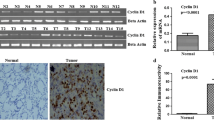Abstract
The purpose of this study was to evaluate the overexpression of cyclin G in colorectal neoplasia, which may be a more frequent event than cyclin D1 during the cell cycle and thus may have a more enhanced therapeutic potential in treating colorectal cancer. Ninety formalin-fixed, paraffin-embedded human colon and rectal specimens were obtained from the Pathology Department of Norris Cancer Center/ University of Southern California. The tissues had been obtained after surgical resection between 1995 and 2001, and had been processed by routine clinical histopathologic methods. Ninety-one percent of colorectal tumors had cyclin G overexpression. These cyclin-positive patients were evenly distributed between men and women, and between tumor locations, that is, 36% rectal tumors and 34% rightsided tumors. Thirty-two percent were well differentiated, and 66% were moderately differentiated. Thirty patients (38%) had stage I disease, 16 (20%) had stage II disease, 25 (32%) had stage III, and seven (9%) had stage IV disease. Eight patients (10%) in this group had recurrent disease during follow-up. There was no correlation between cyclin G overexpression and clinical and pathologic characteristics. Cyclin D1 overexpression was found to be present in only 42% of colorectal adenocarcinomas. There was no correlation between cyclin D1 overexpression and clinical and pathologic characteristics. The present study demonstrates that cyclin G overexpression is a frequent event in colorectal cancer. This frequent event in colorectal carcinogenesis may facilitate new therapeutic approaches acting as a target for gene therapy, possibly directed at downregulating cyclin G in colorectal cancer.
Similar content being viewed by others
References
Vogelstein B, Kinzler KW. The multistep nature of cancer. Trends Genet 1993;9:138–141.
Gillett CE, Barnes DM. Demystified: Cell cycle. Br Med J 1998;51:310–316.
Bartek J, Lukas J. Order from destruction. Science 2001;294:66–67.
Roberts JM. Evolving ideas about cyclins. Cell 1999;98:129–132.
Arber N, Hibshoosh H, Moss SF, et al. Increased expression of cyclin D1 is an early event in multistage colorectal carcino-genesis. Gastroenterology 1996;110:669–674.
Utsonomyia T, Doki Y, Takemoto H, et al. Correlation of beta-catenin and cyclin D1 expression in colon cancers. Oncology 2001;61:226–233.
Jung A, Schrauder M, Oswald U, et al. The invasion front of human colorectal adenocarcinomas shows co-localization of nuclear beta-catenin, cyclin D1 and p16 and is a region of low proliferation. Am J Pathol 2001;159:1613–1617.
Reimer CL, Borras AM, Kurdistani SK, et al. Altered regulation of cyclin G in human breast cancer and its specific localization at replication foci in response to DNA damage in p53+/+ cells. J Biol Chem 1999;274:11022–11029.
Pines J, Hunter T. Cyclins and cancer II: Cyclin D1 and CDK inhibitors come of age. Cell 1994;79:573–582.
Jiang W, Kahn SM, Zhou P, et al. Overexpression of cyclin D1 in rat fibroblasts causes abnormalities in growth control, cell cycle progression and gene expression. Oncogene 1993; 8:3447–3457.
Lovec H, Sewing A, Lucibello FC, et al. Oncogenic activity of cyclin D1 revealed through cooperation with Ha-ras: Link between cell cycle control and malignant transformation. Oncogene 1994;9:709–713.
Sherr CJ. The Pezcoller lecture: Cancer cell cycles revisited. Cancer Res 2000;60:3689–3695.
Weinstein IB. Relevance of cyclin D1 and other molecular markers to cancer chemoprevention. J Cell Biochem Suppl 1996;252:23–28.
Ikeguchi M, Sakatani T, Ueta T, Kaibara N. Cyclin D1 expression and retinoblastoma protein expression in esopha-geal squamous cell carcinoma. J Cancer Res Clin Oncol 2001; 127:531–536.
Bartkova J, Lukas J, Muller H. Cyclin D1 protein expression and function in human breast cancer. Int J Cancer 1994; 58:353–361.
Skotzo M, Wu L, Anderson WF. Retroviral vector-mediated gene transfer of antisense cyclin G1 (CYCG1) inhibits proliferation of human osteogenic sarcoma cells. Cancer Res 1995; 55:5493–5498.
Smith ML, Bortnick R, Sheikh MS, Fornace AL Jr. Chroma-tin relaxation by overexpression of mutant p53, HPV16-E6, or cyclin G transgenes. Exp Cell Res 1998;242:235–243.
Chen DS, Zhu NL, Hung G, et al. Retroviral vector-mediated transfer of an antisense cyclin G1 construct inhibits osteosar-coma tumor growth in nude mice. Hum Gene Ther 1997; 14:1667–1674.
Okamoto K, Beach D. Cyclin G is a transcriptional target of the p53 tumor suppressor protein. EMBO J 1994;13:4816–4822.
Zauberman A, Lupo A, Oren M. Identification of p53 target genes through immune selection of genomic DNA: The cyclin G gene contains two distinct p53 binding sites. Oncogene 1995;10:2361–2366.
Author information
Authors and Affiliations
Corresponding author
Rights and permissions
About this article
Cite this article
Perez, R., Wu, N., Klipfel, A.A. et al. A better cell cycle target for gene therapy of colorectal cancer: Cyclin G. Journal of Gastrointestinal Surgery 7, 884–889 (2003). https://doi.org/10.1007/s11605-003-0034-8
Issue Date:
DOI: https://doi.org/10.1007/s11605-003-0034-8




